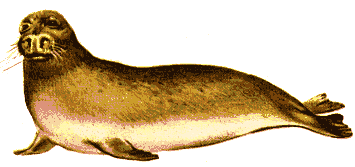
Monachus monachus (Hermann, 1779)

Synonyms: None.
Common names: Engl: Mediterranean monk seal; Russ: Tyulen'; Turk: Akdeniz foku.
Order (Scientific): CARNIVORA.
Family (Scientific): PHOCIDAE.
Taxonomic description: Adult Monachus monachus are robust, with short flippers a long fusiform body, and a proportionaly small head. The head is wide and somewhat flat, with the eyes spaced fairly widely. The muzzle is particularly wide, but compressed from top to bottom. The nostrils are situated at the top of the muzzle. The vibrissae are smooth, females have 4 retractable teats. Coloration varies in low isolated sub populations. Most of the animals are dark, brown. Some of the animals have a large white belly patch.
 IUCN
Status:
IUCN
Status:
World level: CE
Black Sea Regional level: CE
Subregion level: CE
Distribution:
Habitat type, Critical habitats, Limiting factors: Monachus monachus are sedentary animals. Underwater caves, shelters and long quiet beaches are suitable habitat for the species. Marine zone up to depths of 50 metres in the Black Sea. Underwater caves and gravel beaches are the critical habitat for the animals. Loss of habitat, incidental killings, pollution, by catch in nets, over fishing and coastal degradation are the main causes of the decline in the population. However, live capture was one of the reason for the decline in the population in the Black Sea. Only on the Turkish coasts 20 animals were captured before legal protection measures were taken in 1978 in the Zonguldak and Akçakoça areas, (Öztürk, 1996). These captured animals were kept in zoos to show. All the captive animals are now dead. A few individuals still live between Zonguldak-Dogankent in the central Black Sea of Turkey. In additional, some sporadic observations occurred in the Danube delta and Cape Caliacra. The creation of a nature reserve for the monk seal habitat should be an urgent priority for the Turkish Government. In additional, a special public awareness and sensitisation programme should be introduced for fishermen and other local people.
Biology: Sexual maturity reported 4 years of age. Newborn pups have been found at different times during the year, but often in summer and early fall. Observations is suggest that whelping is asynchronous in this species and may take place year round. Gestation considered to be 11 months. The mediterranean species is a shallow water feeder. The diet consists of a large variety of fishes like Sea bream, Sea bass, Mullet, Bonito and Cephalopods.
Population trends: Population drastically declined for the last 20 years.
Threats: Deliberate killing, incidental catch, loss of habitats.
Conservation measures taken: Protected in the Mediterranian basin. This species is under the protection since 1977 in Turkey. Hunting, harvesting, selling, buying and transportation are forbidden both in internal and external markets.
Conservation measures proposed: Inclusion in the Black Sea Red Data Book. In situ protection in the Central Black Sea coast of Turkey. Designation of special protected areas between Doganyurt and Cide. Mass public awareness campaign for the protection of the Mediterranean monk seal is also necessary.
References:
Compiled by: B.Öztürk.